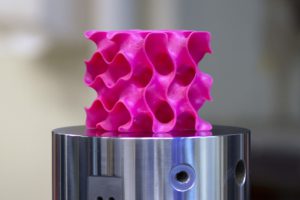Massachusetts Institute of Technology researcher developed a potential new structural plastic using 3-D printers and graphene.
Scientists at the Massachusetts Institute of Technology have discovered new ways to use complex geometry to make strong, lightweight shapes that might be useful as structural materials for airplanes, automobiles and buildings.
The researchers used a 3-D printer and polymers to create the structures, called gyroids, to test their models and simulations originally based on graphene, a two-dimensional form of carbon. Their work showed such gyroids can have exceptionally high strength at light weight, and that these properties mainly come from the geometry of the structures.
An acrylic photopolymer was used in experiments captured on video, but the researchers say the results should apply to a wide range of polymers. 3-D printing seems the best way to make the gyroids given their architectural complexity. Scientists printed the shapes measuring an inch for each side of the cube-like gyroid.
The MIT group is working on patenting the technology, according to Gang Seob Jung, a graduate student who conducted many of the experiments.
So far they have not partnered with any company to take the technology commercial. Resins and chemical giant BASF SE has provided support for the project in conjunction with the North America Center for Research on Advanced Materials.
The gyroid technology would compete with plastic foams often touted for their high strength-to-weight ratio. Mechanical properties of the gyroids, such as stiffness and compression strength, are guided more by their geometrical configuration rather than the inherent mechanical properties of the chosen material.
“The geometry is the dominant factor,” stated Markus Buehler, the head of MIT’s Department of Civil and Environmental Engineering. “It’s something that has the potential to transfer to many things.”

Massachusetts Institute of Technology researcher developed a potential new structural plastic using 3-D printers and graphene
The polymer used in a demonstration video was VeroMagenta, an acrylic photopolymer supplied by Stratasys Ltd. The structures were made on the company’s Objet500 multimaterial printer, which allowed a resolution of 20 micrometers.
The gyroids are porous, three-dimensional structures concocted from two-dimensional geometries such as a sheet of paper. Three-dimensional structures have complex wall shapes that provide much higher strength than their 2-D counterparts. It’s somewhat analogous to rolling a sheet of paper into a tube, creating a structure with much more strength than a sheet of paper.
Researchers adjusted wall thickness of the gyroids and found that thin-wall structures fail gradually under compressive load. Thicker-walled gyroids store the stress as deformation energy and release it suddenly and explosively at the point of failure.
The MIT team found they could predict general mechanical properties when the gyroid is scaled up in size. Their original models and simulations started with nano-scale arrangements of graphene, an exotic form of carbon with enticing strength and electronic properties. They expanded the tiny 3-D structures to a macro-size that could be 3-D printed with a polymer. Mechanical tests on the polymer macro-structure proved the basic principles deduced from nano-scale graphene models.
The research was published in the peer-reviewed Science Advances journal on Jan. 6. Buehler was lead author of the MIT team that also included Jung, Zhao Qin and Min Jeong Kang.
Graphene was the main material used in early models and simulations. Jung said in addition to the VeroMagenta polymer, the team did some work with TangoBlack, an elastomer-type material supplied by Stratasys that mimics rubber.
Jung said the MIT team worked on the gyroid structures for about a year and a half before publishing. Their project did, however, follow several years of work on similar topics in designing high-strength microstructures.
They wanted to find ways of predicting strength properties when a structure is scaled up from a nano scale to a more useful, everyday macro scale. Many natural structures such as bone and some corals are built from strong microstructure building blocks.


